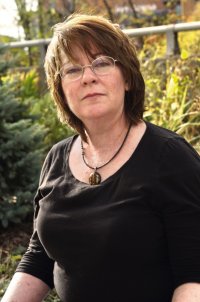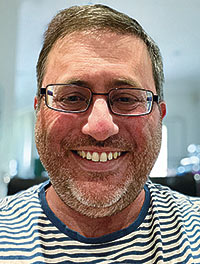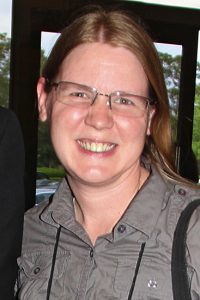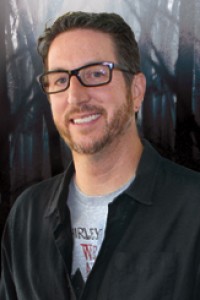Beth Bernobich: Past Lives
 Elizabeth Bernobich was born in Lansdowne PA. Her family moved to the Washington DC area when she was six, and she lived there until leaving to attend Randolph-Macon College in Virginia at the age of 16. She earned a degree in German, including a year abroad at the University of Heidelberg. She has worked as a software engineer for over 25 years, juggling her full time job with a writing career.Bernobich is equally adept at SF, fantasy, and alternate history. Her first published story was ‘‘Version 2.0’’ in 1999, and notable short work includes ‘‘Poison’’ (2003), ‘‘A Handful of Pearls’’ (2007), ‘‘Air and Angels’’ (2008), and ‘‘River of Souls’’ (2010). Her short fiction has been collected in A Handful of Pearls & Other Stories (2010).
Elizabeth Bernobich was born in Lansdowne PA. Her family moved to the Washington DC area when she was six, and she lived there until leaving to attend Randolph-Macon College in Virginia at the age of 16. She earned a degree in German, including a year abroad at the University of Heidelberg. She has worked as a software engineer for over 25 years, juggling her full time job with a writing career.Bernobich is equally adept at SF, fantasy, and alternate history. Her first published story was ‘‘Version 2.0’’ in 1999, and notable short work includes ‘‘Poison’’ (2003), ‘‘A Handful of Pearls’’ (2007), ‘‘Air and Angels’’ (2008), and ‘‘River of Souls’’ (2010). Her short fiction has been collected in A Handful of Pearls & Other Stories (2010).
First novel Passion Play appeared in 2010 and began the epic fantasy Erythandra series, with sequels Queen’s Hunt, Allegiance, and The Edge of the Empire, all forthcoming over the next few years. Her YA Lóng City series began with Fox and Phoenix (2011) and she is working on a sequel, The Phoenix War. The Stories from Éireann series started with the novelette ‘‘A Flight of Numbers Fantastique Strange’’ (2006) and continues through the standalone novella Ars Memoriae (2009) and ‘‘The Golden Octopus’’, which will be adapted with one or two new stories as the novel The Time Roads (2015).
Bernobich lives in Connecticut with her husband Robert. Their son Matthew has just left home for college.
Website: Through the Looking Glass
 ‘‘I come from a family of storytellers. My father told stories constantly, and his sister was an English teacher who not only taught literature in high school but also liked to tell her own stories. In other words, we like to talk a lot. We’re also readers. My brothers and my sister are a decade older than me and they would bring books home from college for me. So when I was a kid, I read The Hobbit, then Lord of the Rings, T.H. White’s The Once and Future King, Dunsany’s The Queen of Elfland’s Daughter. (They brought a bunch of other books, but these were the ones that really spoke to me.)”*
‘‘I come from a family of storytellers. My father told stories constantly, and his sister was an English teacher who not only taught literature in high school but also liked to tell her own stories. In other words, we like to talk a lot. We’re also readers. My brothers and my sister are a decade older than me and they would bring books home from college for me. So when I was a kid, I read The Hobbit, then Lord of the Rings, T.H. White’s The Once and Future King, Dunsany’s The Queen of Elfland’s Daughter. (They brought a bunch of other books, but these were the ones that really spoke to me.)”*
‘‘I would say that I had some of the skills to begin with, but it wasn’t enough. I had to work hard to make sure my prose didn’t turn purple (at least I hope it didn’t), and I had to learn how to create stories that didn’t wander all over the place. Because I read more novels than short stories, I immediately went to novel length, worse, I decided I wanted to write a series – I didn’t know any better, I just wanted to try. The first thing I attempted, after I threw down that novel, was awful. I made so many mistakes with the characters and the story, but I’m stubborn and I was sure that I just had to figure out the right way to tell the damned story. Eventually, after about three novels into the series, I realized I was telling the story about the wrong person, and I was starting at the wrong point. So I wrote a new book, Passion Play, with Ilse as the heroine. That’s the one that sold. Of course that also meant I had to rewrite all the later books, but I didn’t care.”
…
“I wanted to bring my characters to the point where they can’t avoid the hard decisions. They have to stop making excuses and act, they have to try to do the right thing finally – protagonists must protag; they cannot just sit there! But even when they choose and choose well, they’re not going to be rewarded. There is redemption, but at a high cost.
‘‘Although you can certainly fit that theme into a single lifetime, I was intrigued by having it go farther than that and affect not just a single lifetime, but history. (In college, I was also half a history major.)
 ‘‘I’m currently working on the final book of the trilogy, Allegiance (scheduled for 2013). Tor has also bought a fourth book, which is set in the same world and features the same characters 500 years earlier, in a previous lifetime. That one is called The Edge of Empire (set for 2014). I also have a new YA, Fox and Phoenix, coming out this Fall.”
‘‘I’m currently working on the final book of the trilogy, Allegiance (scheduled for 2013). Tor has also bought a fourth book, which is set in the same world and features the same characters 500 years earlier, in a previous lifetime. That one is called The Edge of Empire (set for 2014). I also have a new YA, Fox and Phoenix, coming out this Fall.”
…
‘‘I generally start off with an idea of a character and a situation, and some sort of vivid image – hopefully, even a scene in progress. Then I charge ahead and write for a while just to see how far I can get. (Usually it’s only a chapter or two.) Once I have a chunk of text, I sit back and say, ‘OK, what’s the shape of this story? Who are these people and where are they going?’ And most important of all, ‘What matters here?’ Then I make a file of notes and ideas, what I call a set of goalposts for writing. An almost-outline. I’ve tried writing without an outline, but the story tends to wander off into a swamp of plotlessness and die an ugly, miserable death. But the outlines aren’t very detailed. Mostly, I figure out the beginning and the end, while in the middle I have a bunch of vague things that say, ‘more stuff happens,’ or ‘political maneuvers take place here,’ or, ‘don’t forget the goats.’ ”



 Excerpts from the interview:
Excerpts from the interview:



Pingback:Locus Online Monitor » New Books, 18 October